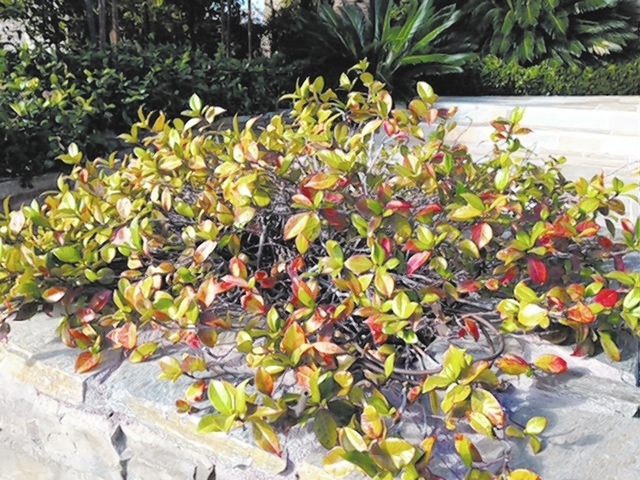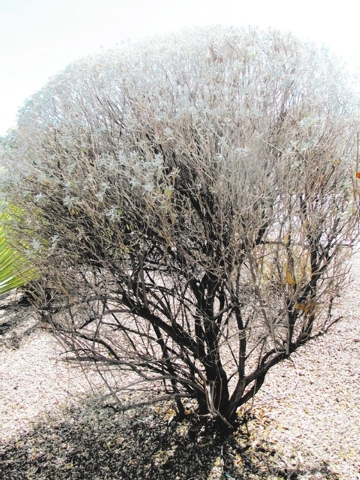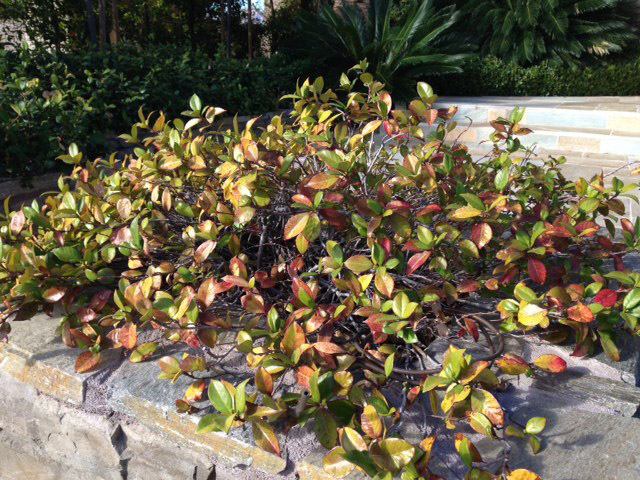Mild freeze can damage star jasmine
Do you want bigger and better quality fruit? Learn and come help us thin fruit at the University of Nevada Cooperative Extension orchard, near North Decatur Boulevard and Horse Drive in North Las Vegas. Now is the time you should start. Then go home and do it to your trees!
Classes, followed by fruit thinning workshops, will be 9 to 11 a.m. Saturday and Tuesday.
Q. What is the best way to fix frost damage to star jasmine? Give it nitrogen and iron? Wait for warmer temps? Or replace the plant?
A. Mild freezing damage to many plants, including star jasmine, discolors the leaf causing it to yellow or bronze but not die. At lower temperatures the leaf may scorch, drop from the plant or die back and still remain on the plant.
If winds are light, cold damage during mild freezes is more severe at distances farther from the ground. The ground can radiate heat up to the plant, keeping the lower portions from freezing, if winds don’t continually blow it away.
If tender plants grow both above and below a wall, it is not uncommon to see the top portion damaged while the parts below the wall remain in good condition.
You sent me a picture of a star jasmine used as a ground cover. In the picture, most of the discoloration from cold is in the upper part of the plant. That discoloration is permanent to those leaves.
You have two options: Let it grow out of it in the next couple of months and prune out some unsightly parts that still remain or make some deep pruning cuts inside the canopy. These deep cuts will be focused on stems with loss of leaves or discolored foliage.
Follow up with an all-purpose flowering tree and shrub fertilizer and some irrigations to wash it into the root zone. I would not replace the plants.
Q. I have two Swan Hill olive trees in the backyard. One has lost a lot of leaves and looks sparse and the other looks good. I sent a couple of pictures of the problem tree. Do you think it could have Verticillium disease that you mentioned in your newsletter?
A. The tree looks pretty young and I would not expect it so soon in its life, if at all. This disease is not common here considering all the olives we have.
It is hard to know if the disease is present or not just by looking at an olive tree. Olive has few problems.
This disease is frequently deduced like this. Verticillium wilt causes limb dieback in trees. My olive tree has limb dieback. Therefore my olive tree has Verticillium wilt. That’s how it is diagnosed without sending a sample to a pathologist.
Typical Verticillium disease symptoms do not occur in olive like they do in other trees. Upon close inspection of an infected limb, olive looks normal instead of having the vascular streaking common to that disease in other trees.
Two things you can do; watch it and see if it gets worse or send a sample to the state pathologist with the Nevada Agriculture Department. This would be in Carson City. His contact information is on its website or call the local office at 702-486-4690.
I would not cut any limbs or remove them until you have some better idea of what is going on. Get it from a source that does not profit from tree removal. In the meantime, water it frequently and deeply. Fertilize it now for good growth.
Q. I planted several irises in my yard about seven years ago. They bloomed for many years but the last two years they had no blooms. Is there anything I should be doing?
A. The usual problem when iris is not blooming is not dividing them. Iris must be dug up, divided and replanted periodically.
They must be dug up, the rhizomes severed, dusted with a fungicide and left to heal for a day or two in the shade, then spaced appropriately and replanted. Throw out damaged or rhizomes that are too small unless you want to baby the small ones until they get enough size to bloom.
Distances apart depend on the size of the iris; smaller ones closer together and larger ones further apart. Taller ones toward the back and shorter ones near the front of the bed.
Replant them with compost and a fertilizer such as bone meal to improve rooting. Fertilize once a month lightly with a good quality fertilizer for flowers.
But overcrowding them will cause them to stop blooming. They have been in the same spot for seven years so I am figuring the light is the same unless nearby trees got bigger and limited sunlight. That will also decrease blooms.
For watering a large iris bed use low pressure, in-line drip emitters in half inch poly pipe such as Jain or Netafim brands. Space the pipe about 12 inches apart parallel to each other throughout the bed. The pipe can be laid on top of the soil, just under mulch.
Q. My Texas rangers have become very woody at the bottom and sparse on top. What should I do and when should I do it?
A. Judging from the picture, they have been pruned with hedge shears instead of growing more naturally. This caused the outside of the canopy to become sparse of leaves with lots of older, interior wood.
You have three options. Let them get larger. This will allow them to put on sufficient new growth on the outside to cover up the sparseness of the foliage and the very old interior wood.
Secondly, you can do some corrective pruning. This may make them ugly for a couple of seasons but you will be on your way to re-establishing the plants with a better appearance and longer life.
Corrective pruning would require two to three cuts deep inside the canopy, opening it for new growth and re-establishing a fuller canopy.
The following year remove two more stems the same way and let the canopy regrow. By the third year you should have removed most of the older wood and the shrub should be well on its way to looking and performing better.
Third option is to pull them out, replace them and start pruning the correct way without a hedge shears.
Bob Morris is a horticulture expert living in Las Vegas and professor emeritus for the University of Nevada. Visit his blog at xtremehorticulture.blogspot.com. Send questions to Extremehort@aol.com.



















